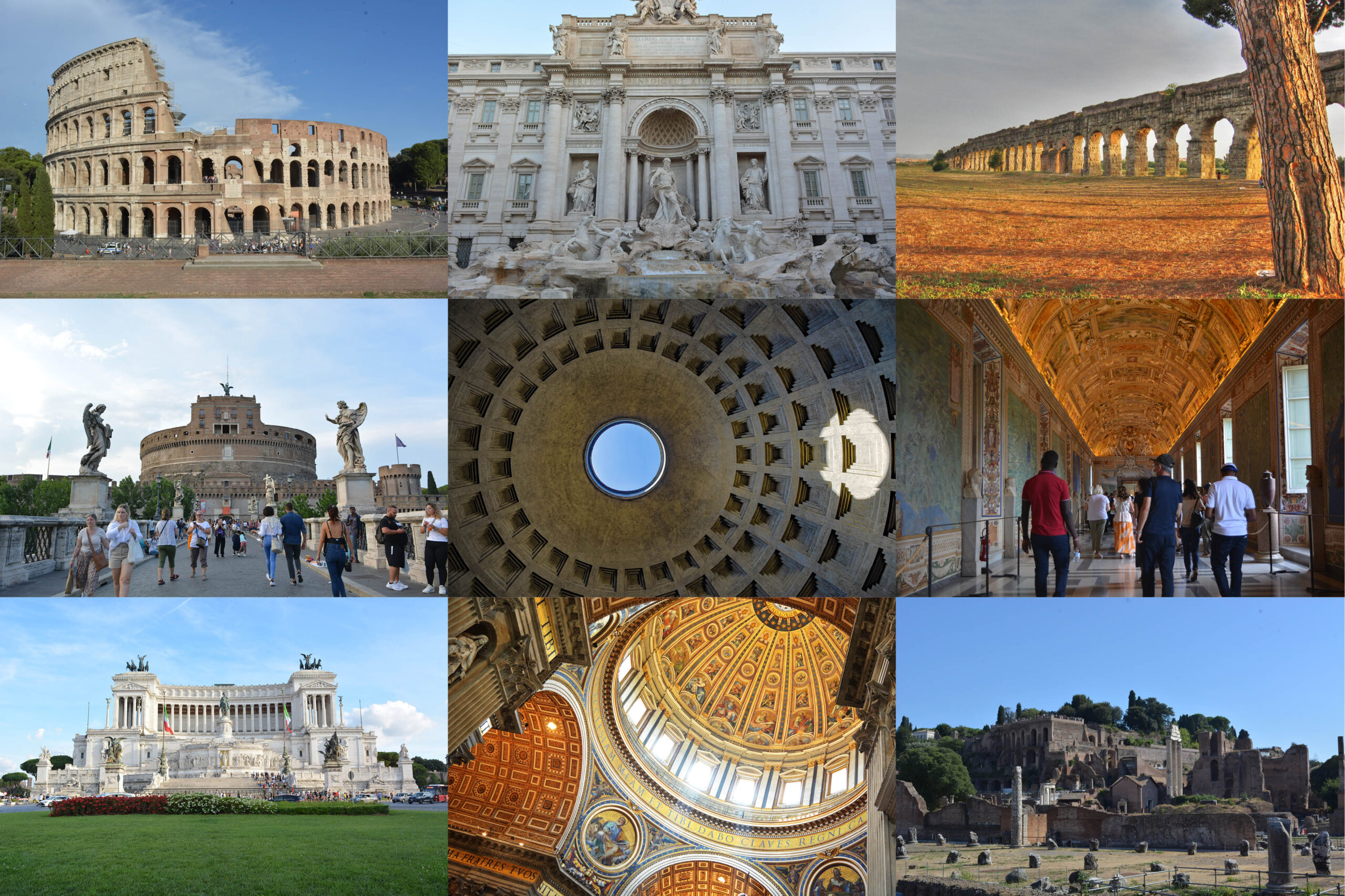Last Updated on: 1st April 2024, 07:42 pm
Rome is a city with over 2,700 years of history whose empire spanned throughout Europe, so it is not surprising that Rome has a vast number of sites that may be of interest to various types of visitors. This practical guide narrows it down to the top 9 attractions in Rome, Italy for 2024 for all tourist types and is the perfect introduction for a first trip Rome. Attractions in the list is based on their historical significance and/or visual impressiveness. The list covers the major reasons for visiting each attraction and is listed in the order of the author’s personal recommendation based on considerations of attraction awesomeness, tourist worthiness, and time, effort and cost required to visit each venue for the average tourist. Your priorities may be different depending on your personal preferences.
In order of recommended priority, the 9 must-visit sites in Rome are:
#1: Colosseum – Paid
#2: Trevi Fountain – Free
#3: Roman aqueducts – Free
#4: Castel Sant’Angelo – Paid
#5: Pantheon – Paid
#6: Vatican Museum – Paid
#7: Vittoriano – Free
#8: St Peter’s Basilica – Free
#9: Roman Forum – Paid
#1: The Colosseum - Paid
Its instant recognisability, easy access and very close proximity (right outside) to public transport, a short ride from the city center and Rome central station, accessible site and under cover/all weather friendly puts it firmly at number one.
Location:
Piazza del Colosseo (the Colosseum plaza/square), directly outside Colosseo metro station (Line B), on the corner of Piazza del Colosseo road and Via Celio Vibenna road.
Accessibility:
Wheels accessible with lifts for those who cannot use stairs.
Official website and tickets:
https://colosseo.it/ (opens in a new tab for uninterrupted reading)
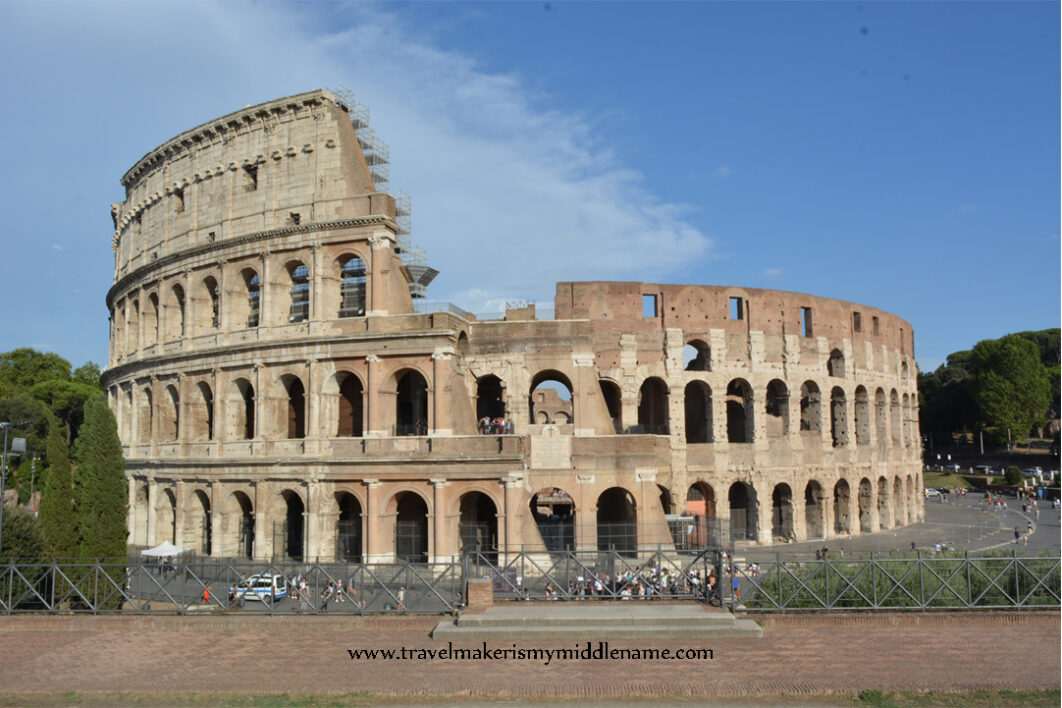
What it is:
The Colosseum is undoubtedly the most recognisable icon of Rome, and one of the most famous historical landmarks in the whole of Italy and one of the attractions in the Colosseum Archaeological Park. The Colosseum an oval shaped sports stadium used for spectator sports entertainment such fights between animals and humans. With an estimated seating capacity of 50,000 to 80,000 spectators, and at 189 metres long, 156 metres wide, and approximately 50 metres high, it is the largest amphitheatre in the ancient world. To top it off, it only took 8 years to build.
What you can see:
General admission lets you can see where the animals used to be kept before being allowed into the fighting arena, where spectators sat, go into the arena itself (special ticket required), see the view of the Colosseum plaza from the upper floors out of the Colosseum, and simply appreciate the work involved in creating this structure. There are also interesting permanent and temporary exhibits with information to read and learn about, as well as a gift shop. The arena is not included in the general admission and is only open for visitors who buy a ticket that includes the arena.
A visit to this remarkably well preserved ancient work of Roman engineering is practically compulsory for any first time visitor to Rome. but modern upgrades mean the Colosseum is now accessible for all with lift access to the upper levels, so there is no excuse not to go.
How long to spend here:
The Colosseum can be toured in a about 2 hours (provided that you buy tickets to the Colosseum online beforehand so you do not have to wait in a queue) give or take an hour depending on how thoroughly you want to investigate the exhibits there and whether you want to read all the information, and excluding queueing time of around 20-30 minutes (visitors have to queue for the entry time specified on their ticket), so even if you just have one day in Rome, this can be done. And even if you don’t have the time to tour the inside in detail or do not want to spend money on a ticket, the Colosseum can still be seen in all 360° from the outside for free.
Find out more about visiting the Colosseum (links opens in a new tab for uninterrupted reading).
#2: Trevi Fountain - Free
Located a short walk from a bus top and accessible 24/7, the Trevi Fountain is a free, visually attractive, culturally significant and understandably, a highly popular attraction that is practically compulsory and a pleaser for all tourists.
Location:
Piazza di Trevi (on the corner of alleyway Via della Stamperia and the main street Via del Lavatore)
Accessibility:
The immediate area surrounding the fountain itself is accessed by stairs, but once you get there, the ground is flat and paved with cobblestones. The area beyond that is also flat.
Official website (information):
https://www.turismoroma.it/it/node/1286 (opens in a new tab for uninterrupted reading)

What is the Trevi Fountain?
Water fountains in ancient Rome was a symbol of prosperity and wealth because of the skill and costs involved in creating these highly purposeful public infrastructure. Rome, and indeed Italy as a whole, has many public water fountains. While The Trevi Fountain might not be the oldest water fountain in Rome, it is widely accepted as the most beautiful one and definitely the most famous one.
The design of this fountain is simply an extended facade, rather than a 360º circular fountain in the middle of an open area which is what most other fountains are, meaning it can only be admired from one side – the front.
What can you see at the Trevi Fountain?
Crowds, mostly.
Just kidding (not).
Unlike most other water fountains which are circular, the Trevi Fountain is a facade fixed onto a building located in the middle of an urban cluster of buildings surrounded by several small alleyways. The fountain is 26 metres high by 49 metres wide and is supplied with water from an actual aqueduct. It is adorned with fully three-dimensional sculptures, not simply reliefs. It has one large basin at the bottom into which water falls from a smaller basin above. The pool has a naturally blue colour. The water is not drinkable today because of the many coins visitors toss into it, and the fact that the water is recycled but you can still look at and touch it, and throw coins into it. Twice a week the water flow is stopped, the fountain is drained, the coins collected, and the basin given a thorough clean. If you happen to come when this is happening, you can see this process. You might also see people coming to get wedding photos taken.
Being a building facade directly facing the street, there is no entry or open and close time, so expect crowds at all hours of the day and well into the night.
Tip: If you stay nearby, you can always stroll over and visit any time you like, even more than once as it is part of the streetscape.
#3: Roman Aqueducts - Free
One of the Roman empire’s most amazing creations is the aqueduct system that gave them what is essentially running drinking water. Aqueducts feed the Trevi Fountain like it has fed the entire empire for thousands of years, yet it it not recognised as Rome’s top attractions, so it is about time that it is.
Location:
Varies, main one is Park of the Aqueducts with several entrances, see below,
Accessibility:
The park has grassy areas which may not be smooth enough for wheels
Official website (information):
https://www.parcoappiaantica.it/smart-info-ita-eng/ (opens in a new tab for uninterrupted reading)

Think about how the water gets to your hotel room or home for a moment. Just 200 years ago, most people had to manually fetch water from wells.
Yet the ancient Romans built aqueducts, which today are over 2,000 years old, to provide running water to their city, using only gravity and ingenious engineering. You can visit a 2,000 years old aqueduct that is still in use today.
What are aqueducts?
Aqueducts are structures and systems of pipes and canals built to direct water from a source to where it is needed, such as to cities or for agricultural use. While most other civilisations were manually collecting water from wells, the ancient Romans built aqueducts that brought the water to the user. The ancient Roman aqueducts are not on top tourist sight seeing lists for Rome which is a shame, so I am making a point to include it at the top of the list here for you.
Where can you see the Roman aqueducts in Rome?
There are several remnants of aqueducts throughout Rome, but the Park of the Aqueducts is a formally protected area with several aqueducts to see. The park that almost wasn’t, this public park contains aqueducts that are over 2,000 years old set in hectares of park land. The park only became a formally protected area in 1988 and is located in suburban areas outside the main center of Rome near the boundary of Rome city, but is well worth the trip and takes no longer to get to than the Vatican City. You can bring a picnic lunch to eat on the grassy fields, admire actual historical artefacts up close, away from the distracting buzz of the city, and is a must for history buffs and highly recommended for any other type of tourist. You can walk right up to and through the arches of the aqueduct.
Location:
There are several entrances to the park. The park is part of the Appian Way Regional Park. Check out the map on the Appian Way’s official website above to find the most convenient one for you. The closest bus stop is for route 557, and the closest metro stops are Lucio Sestio, Giulio Agricola, or Subagusta. See the link above for the map of the Park of Aqueducts.
Acquedotto Alessandrino is another aqueduct nearby, about 3 km away from the Park of the Aqueducts in a much smaller park that is part of the immediate suburban landscape, running along modern asphalt roads.
#4: Castel Sant'Angelo - Paid
Castel Sant’Angelo is a mausoleum commissioned by the Roman Emperor Hadrian in 135 CE that was also used as a fortress and prison. It as once the tallest building in Rome and today still provides an excellent high perspective view of Rome. Today it is a museum. The preserved grounds still look like like the way it may have thousands of years ago and makes an interesting day trip to ancient Rome.
Location:
Lungotevere Castello, 50, Rome.
Accessibility:
The bridge between the street and the castle is flat and wheels friendly, however the castle itself contains stairs that are not wheels accessible. Contact the museum to ask for specific information before you go.
Official website and tickets:
http://castelsantangelo.beniculturali.it/ (opens in a new tab for uninterrupted reading)
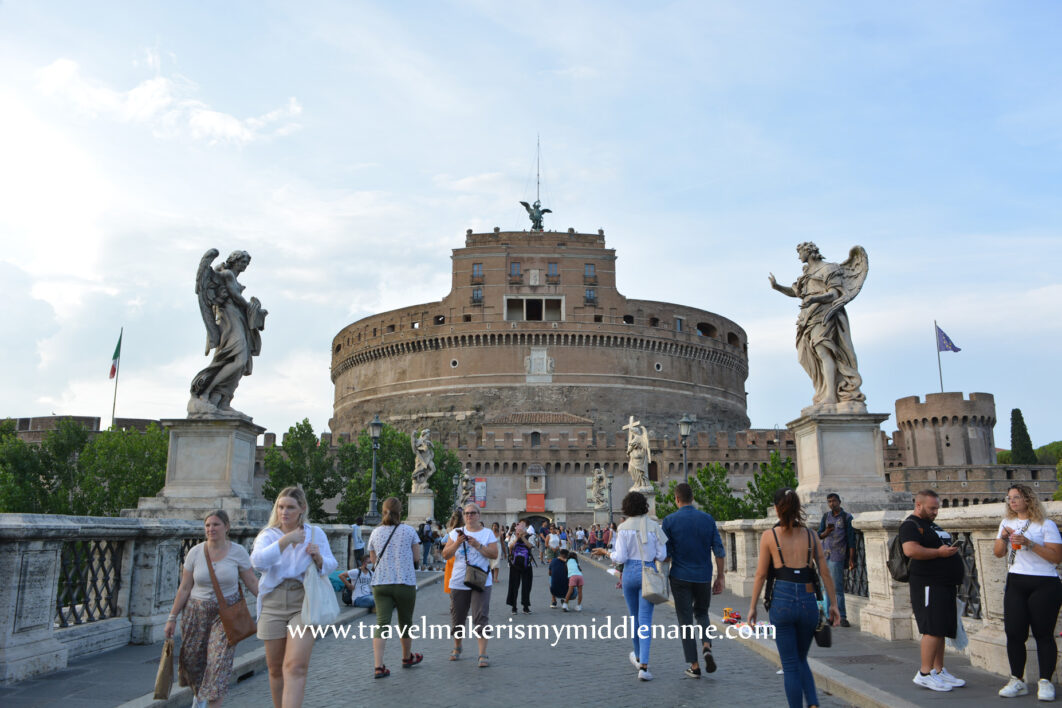
What is the Castel Sant’Angelo?
The Castel Sant’Angelo was originally built as mausoleum, commissioned by the Roman Emperor Hadrian in 135 CE. Like many pagan things, later on, it was taken control by the Catholic popes, who turned it into a castle and fortress with the intention of turning it into a refuge for the pope. It was also used as a prison.
What can you see in the Castel Sant’Angelo?
The interior is grand and in typical fashion of many ancient buildings in Rome, the walls and ceilings are covered in detailed paintings. The grounds are well preserved you can walk through one and pretend you are in an ancient Roman town. You can also get an excellent high point view of Rome at the top. The bridge also extends over the River Tiber, and you can see the sculptures that line the bridge.
The Castel Sant’Angelo is just 850m from the edge of the Vatican City, so you can see st Peter’s Basilica from afar.
How long to spend at the Castel Sant’Angelo?
2-3 hours should suffice, not including queuing time which can take an hour or more in peak tourist seasons.
#5: Pantheon - Paid
The Pantheon is a small temple of significant archaeological value as it is the oldest, most complete, and best preserved structure of the entire ancient Roman empire. Its main feature is the famous concrete dome with a hole in the center. Its close proximity to the city center and easy access by public transport places this no-fuss, quick visit attraction at number 5.
Location:
Piazza della Rotonda (the block surrounded by Via della Rotunda road, Via della Minerva and Via della Palmonbella on the west, east and south respectively.) Centrally located and easily accessed by bus.
Accessibility:
Like many, if not all, of the major historical buildings in Rome, the floor is made of smooth marble, and there are ramps for wheel access.
Official website (information):
https://direzionemuseiroma.cultura.gov.it/pantheon/ (opens in a new tab for uninterrupted reading)
Official Website (Tickets):
https://www.museiitaliani.it/en/buy-tickets (opens in a new tab for uninterrupted reading. At time of writing, you need to search for “Pantheon” to find the tickets and create an account/log in to buy tickets)
What is the Pantheon?
Ancient Rome was polythestic, meaning people worshipped more than one god simultaneously. The Pantheon (not the Parthenon!) was built over 2,000 years ago for the 12 Roman gods in ancient Rome, with the name “Pantheon” meaning “temple of all gods”. Again, unfortunately, like many pagan things, it was ultimately hijacked by Christianity, so today is simply a Christian church dedicated to St Mary, hence the modern Italian name “Basilica Santa Maria ad Martyres” (Basilica of St. Mary and the Martyrs).
What can you see:
Although smaller in size, the Pantheon is worth visiting for people with archaeological interests as it is the oldest, most complete, and best preserved structure of the entire ancient Roman empire. For others, its most famous draw card is the result of clever ancient engineering: the unsupported concrete dome with a hole in the center, which, at 43 metres wide and 22 metres high and completed in 125 CE, was the largest dome in the world for a good 1,300 years (until the Duomo, or Cathedral of Santa Maria del Fiore, was completed in 1436) and remains today as the largest unsupported dome in the world. This was achieved by removing excess weight in the form of the perfectly sized, arranged, meticulously designed and calculated concentric square recesses in the dome, so the roof does not collapse on itself. The open hole at the top of the dome serves the same purpose as well as being the only source of light in the building.
How long to spend at the Pantheon?
Functionally speaking, the Pantheon is a just a church, and the biggest attraction to tourists is the dome, so about 30-45 minutes is sufficient for the average tourist, plus about half an hour of queuing during peak seasons.
#6: Vatican Museum (Paid)
“How can the Vatican museums be in 6th place?!” I hear you ask. Despite the impressive artwork on display, the long wait times and high percentage of disappointed patrons (8.4% of 1 and 2 out of 5 star ratings on TripAdvisor as of 13th of March 2024) and the unexpected smallness of its main attraction, the Creation of Adam and the overall poor experience of the Sistine Chapel means it is difficult to recommend this any more for the ordinary, non-religiously devout tourist.
Location:
“Vatican City” area in Rome.
Accessibility:
Wheels friendly, prams are not allowed for space reasons (store outside before entry).
Official website and tickets:
https://www.museivaticani.va/ (opens in a new tab for uninterrupted reading)
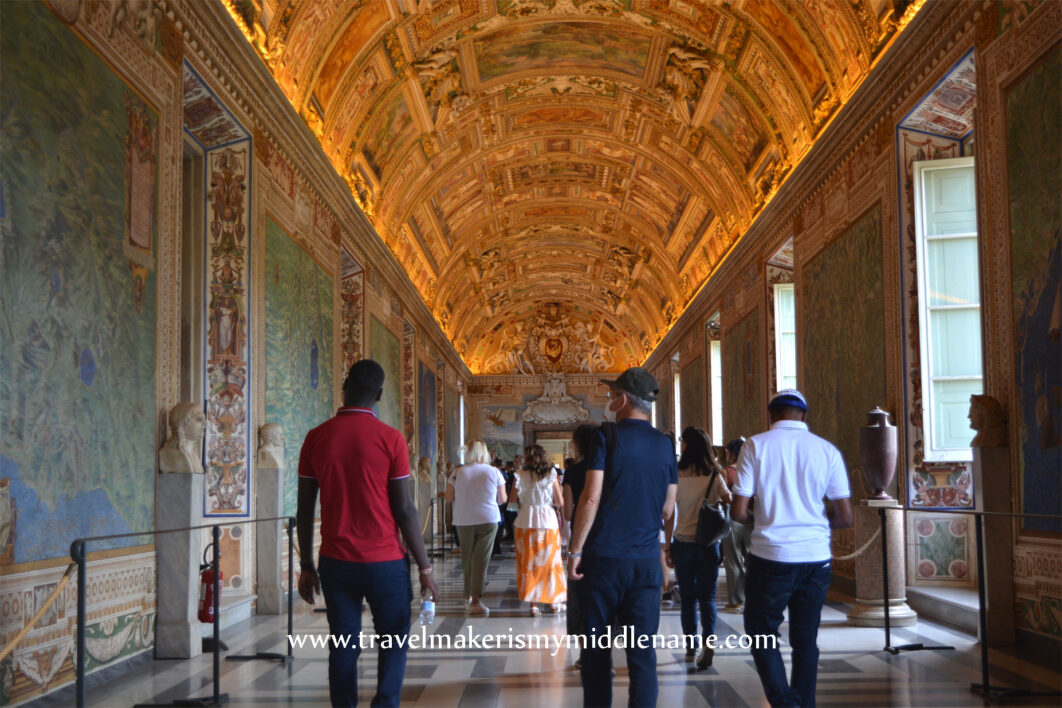
What is the Vatican Museum?
Located in the same vicinity as St Peter’s Basilica, the Vatican Museum is a ticketed attraction that houses numerous art exhibits to see and learn about. The Vatican Museum is a series of museums/rooms in the same building connected by halls and stairs (wheels accessibility is available) that contains both modern works of contemporary art as well as centuries old works by Michelangelo and Raphael of religious and historical significance, but visitors absolutely do not have not be religiously affiliated to appreciate the skill that went into creating the artwork.
Long queues are expected but can be avoided if you purchase a tour for express entry.
There are many individual museums and things to see at the Vatican Museum. Many pieces demonstrate the skills of dedicated artists. Exhibits include three dimensional sculptures, two dimensional paintings, two dimensional paintings that look three dimensional, frescoes, and my favourite, exquisitely detailed tapestries. Most of them are religious themed in at least some way, but at the very least are still of factually historical significance (such as artworks by Michelangelo and Raphael) and can be admired for their exquisite artistic and technical skill alone. The tapestries on display are on rotation to prevent deterioration. You can learn about the diligent work undertaken that restore the tapestries, by matching the colour and material of the individual threads.
The main attractions at the Vatican Museum are the “Creation of Adam” by Michelangelo, which is located in the Sistine Chapel, the Sistine Chapel itself, and the Bramante Staircase. The Sistine Chapel is the last significant room of exhibits to see before exiting and the Bramante Staircase is literally the exit out of the museum (past the gift shop). If you want to visit the Bramante Staircase only, you can purchase a ticket just for that.
DISAPPOINTMENT ALERT:
If your only reason for visiting the Vatican Museum is to see the “Creation of Adam” and/or to see the Sistine Chapel:
1. I will spare you the suspense and tell you that it is a very small painting in the center of the ceiling hidden amongst the numerous other equally amazing works. Don’t fixate on the Creation of Adam piece.
2. The Sistine Chapel is also very dim, and the ceiling is very high, about 20 metres from the floor. If you need them, remember to bring your glasses/binoculars! It would be terrible if you waited the whole time and paid to get in, only to see nothing.
3. Despite being the official residence of the pope, the Sistine Chapel is not a ‘sacred’ place of quiet spiritual contemplation that some may think it is. It is a small room that every visitor to the museum wants to spend the most time in. This invariably makes it not quiet and abuzz with conversation, despite guards and signs regularly reminding people to be quiet, so many have complained that the experience is not a positive one, however its popularity means there is not much to be done about it, short of severely restricting the number of visitors and maximum stay duration each. My tip is to just take the paintings at face value/admire the talent involved in creating them, and forget about expecting any sacredness.
4. Photography is not allowed for commercial reasons (you can read about this here, opens in a new tab), and guards may remind people about this repeatedly but don’t expect people to follow this rule. Just be sensible, discreet, do not use flash, and do not bring a tripod.
In summary, if you can look past the borderline chaos in the Sistine Chapel and the religious significance once you get in, the incredible skill of the artists that created the stunning artworks can still be enjoyed without a doubt.
In summary, the artwork in the Vatican Museum is worth seeing if you take the time to look and not just see.
How long to spend at the Vatican Museum?
3-4 hours is recommended to walk through and admire the exhibits of the Vatican Museum, not including queuing time which can be several hours, and gift shop stops. You can get express entry by joining a tour group or pre-purchasing your ticket online with a specified entry time, and purchase a ticket just for the Bramante Staircase only, if that is the only thing you want to see.
Itinerary Planning Note:
Even with express entry, taking into account getting to the museums, entering the museum, seeing all the exhibits and gift shop, then making your way out of the museums and to your next point of departure, a proper, non-rushed trip to the Vatican Museum would most likely take up at least half a functional day if not the good part of a whole one: you cannot bring food or drink into the museum so you will also have to account for time for lunch, as well as time getting to another sightseeing venue, and keep in mind that other venues would have their own opening hours with last entry times.
#7: Vittoriano - Free
A baby in comparison, the Vittoriano is a large national monument that took 20 years to build starting in 1885, to honour the first king of Italy, Victor Emmanuel II, in Rome, Italy. This free attraction with a panoramic terrace and significance in Italy’s modern history is located conveniently within Rome’s city center and access by bus right in the piazza.
Location:
Piazzale Venezia
Accessibility:
Lifts are available for wheelchairs and strollers.
Official website and tickets:
https://vive.cultura.gov.it/en/vittoriano (opens in a new tab for uninterrupted reading)
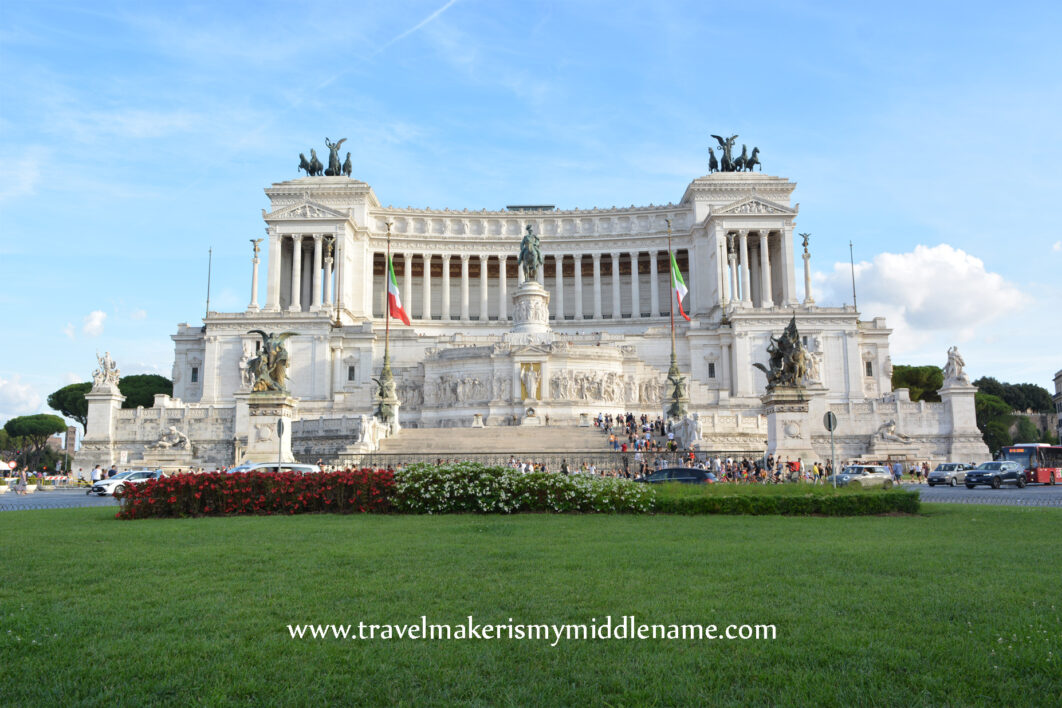
This building is known by many names, Vittoriano, Altare della Patria, Victor Emmanuel II National Monument or colloquially, the Wedding Cake, due to its white and multilayered stacked design. The Vittoriano was constructed to honor Italy’s first king after his death. Completed in 1905 means it is basically a baby compared to the other famous attractions of Rome. However, it is unique because it was for Italy’s first king so is of historical significance and since then gone through Italy’s history: from the unification of Italy to the democratic European nation it is today.
There is a terrace at the top of the monument and visitors can see the changing of the soldiers at the Tomb of the Soldier once every hour. Two soldiers guards the tomb 24/hours a day and it has been this way since 1921. That is a long time to stay awake 🙂 ! Also note that the hedge at the front on Piazalle Venezia is planted in the colour of Italy’s flag.
Entry to the Vittoriano is free, although it is part of a collection of museums called VIVE, which requires a paid ticket if you want to go to the other museums. The Piazza Venezia it is easily accessed by many buses, it does not yet have a metro station, but a new metro station is underway in 2024 for Line C.
#8: St Peter's Basilica - (Free)
St Peters Basilica’s cavernous and elaborately decorated interior wows visitors who are patient enough to queue hours for entry with an impressive demonstration of amazing artistic skill and construction. Unfortunately, the main attraction, the almost-29 metre tall canopy over the tomb of St Peter, is completely hidden from view by scaffolding for most of 2024, and in the process, blocking the view of the dome above it, significantly dropping the basilica to number 7 on the list.
Location:
“Vatican City” area in Rome
Accessibility:
Wheelchair accessibility is available, however children’s prams are required to be stored in the free service cloakroom before entry.
Official website:
www.basilicasanpietro.va/it.html (opens in a new tab for uninterrupted reading)
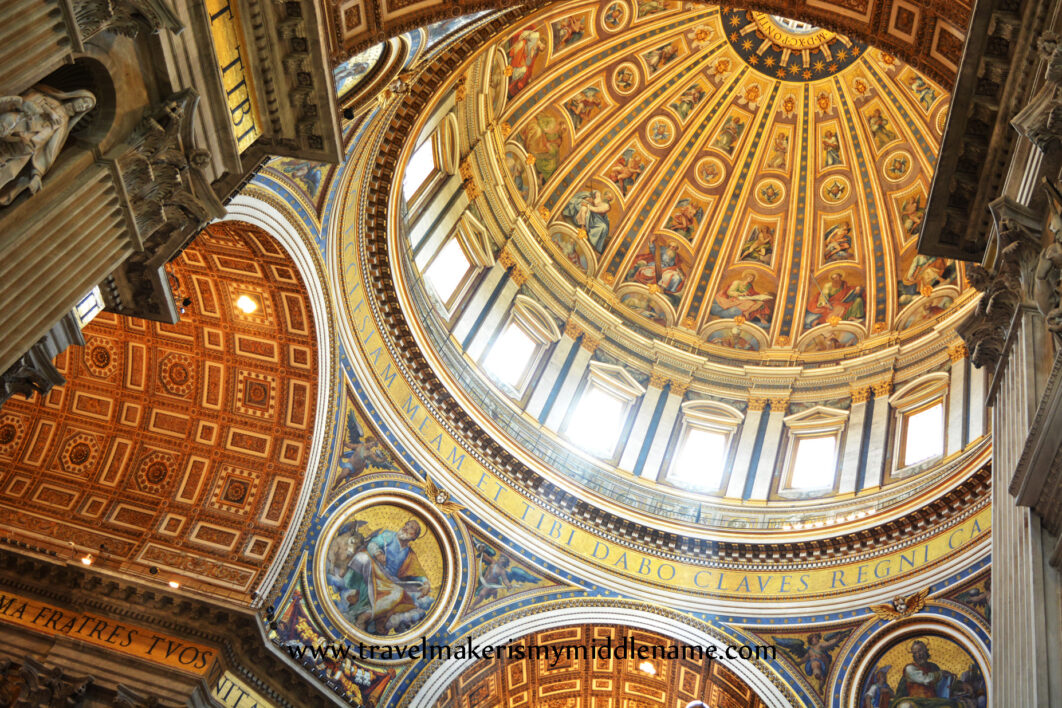
What it is:
St Peter’s Basilica is a huge, excessively extravagant church built not for god, but for and named after Peter, one of Jesus’ mortal disciples in Christian folklore, who is allegedly buried inside the basilica (the basilica was built around his supposed burial site). This massive building is over 130 metres tall including the dome and is relatively younger than the more ancient ones in Rome, with construction started in 1506 and lasted over 100 years. You absolutely do not have to be religious to appreciate the immense amount of art and construction skill involved in creating this gigantic and awesome piece of architecture. Its popularity and free entry means queues of around 2 hours is not unusual which can be gruelling in the summer, but the impressiveness that awaits you inside, is well worth the wait outside.
What you can see:
St Peter’s Basilica is an absolutely amazing work of visual art, sculptures, architecture, construction and engineering that is well worth the long wait (about 2 hours) for all visitors who appreciate architecture and art, no religion affiliation needed. In fact, if you only have two days in Rome, this is one of the things you absolutely must see.
The inside of the massive church is naturally cool in summer, and contains beautiful paintings, mosaics, sculptures, marble floors, carvings, altars, and detailed wall and ceiling decorations, the tombs figures important to Christians; and rows of chairs available for those who want to sit to admire the works.
But the main attraction, or at least one of them, is the painted underside of the cavernous dome built directly above the other main attraction: the canopy that stands over the main altar built over the supposed tomb of Peter. Just the canopy above the altar is almost 29 metres tall and made from bronze, with an estimated weight of 63,000 kilograms. The height of the building including the dome is 136 metres.
So why is this impressive piece so low on the list for 2024?
Ordinarily this would have been number 2. But, while “impressive” is an understatement, unfortunately, the main attraction, the canopy above the altar (the Baldachin) will be hidden from display for about ten months in 2024 while it is fenced up for cleaning and restoration for the first time in 250 years. Although the basilica remains open nonetheless, it means that visitors will not be able to see the canopy, nor the impressive paintings on the underside of the dome, which stands directly over the canopy. If you can only be bothered to wait hours to get in once, it’s better to go when the canopy is on display. Even though the rest of the massive church is still interesting to explore, it is more due to the fact that it is so large than anything else, and the dome is still open to climb, although you won’t be able to see the paintings in the underside of the dome while you are in it yourself. I strongly recommend you go when the canopy is open so as not to waste your time and to get the full WOW factor on your first impression.
Tip:
A pair of binoculars will surely help you see the detail on the ceiling and dome. For those who need it, bring your glasses! Do not attempt to go without your glasses, if you forget, go back to your hotel to retrieve them, you’ll probably be waiting for 2 hours anyway and taking the next bus won’t make much of a difference but those glasses will! And if you are really interested in history, you can book and pay to enter the actual necropolis under the basilica, with number of visitors per day limited to 250, through their office.
How long to spend here:
It is said that 2-3 hours is required if you want to thoroughly explore the basilica in detail, not including queuing time. Although, at least on the day I visited, perhaps at least partly due to the fact it was closing early afternoon, people were urged to move through quickly, and without access to the upper floors or a pair of binoculars, you really cannot see very much above anything higher than ground level since all the detail and exquisiteness is high up on the walls or ceiling and we were out within an hour. Opening and closing times and days change so check on the official site before going. Also keep in mind that depending on the size of the crowd, entry may close earlier than usual.
#9: The Roman Forum
The Roman Forum was the city center, the CBD of ancient Rome, where people conducted tasks of daily life, but due to the state of disrepair, it requires some imagination on the visitor’s part. The Roman Forum is likely more attractive to archaeology lovers.
Location:
Entrance via Piazza del Colosseo near the Colosseum on the same ticket.
Accessibility:
Terrain include flat unsealed paths, grass, sealed or paved paths, some slopes, stairs and hills. Attractions and buildings open to the public have ramps installed.
Official website and tickets:
https://colosseo.it/ (opens in a new tab for uninterrupted reading)

What is the Roman Forum?
No doubt less well known compared to its neighbour the Colosseum, the Roman Forum still an important site if not as visually interesting. Located right next to the Colosseum and included on the same ticket, the Roman Forum is the other attraction part of the Colosseum Archaeological Park. It is essentially a public square or the ancient CBD of Rome that contained the facilities and services that were central to ancient Roman society: markets, government buildings, libraries and temples. It is an open air, outdoors fenced up archaeological site that you can walk through and see the ancient Roman ruins up close.
What can you see at the Roman Forum?
A large amount of the structures are in ruins, at any time, other buildings may be closed for restoration works or cannot be entered, others can be entered and even included in the ticket but the interiors have been modernised, so it does require some imagination to enjoy, and may not be of as high an interest for some people.
However, the fact that such a site exists show the contemporary thinking that the ancient Romans had in society and town planning policies to have a purpose built central business area, essentially no different to today’s society and CBD. The more ancient basilica, the Basilica of Maxentius and Constantine (commissioned by Emperor Constantine and opened in the year 312 CE) is also located in the Roman Forum. Entry is included in the ticket to the neighbouring Colosseum. The site is in a sunken area so visitors who do not want to enter can also walk around the outside to look inside from afar. And despite being included on the same ticket as the Colosseum, if you have something better to do, by all means, go to that instead. Read more about visiting the Roman Forum here. (link opens in a new tab for uninterrupted reading).
Like this post? Subscribe to get notified of new posts!
Related Posts
-
Omarama Top 10 Holiday Park - A Review
This post is a review of Top 10 Holiday Park, a camping and caravan grounds…
-
Venice, Italy - An informative guide for first time visitors
What is Venice city? Where is it? How to get to Venice, plus cheapest airport…
-
A trip to the Cinque Terre, Italy: Beautiful views and the disappointing seafood
What my visit to Cinque Terre was really like

